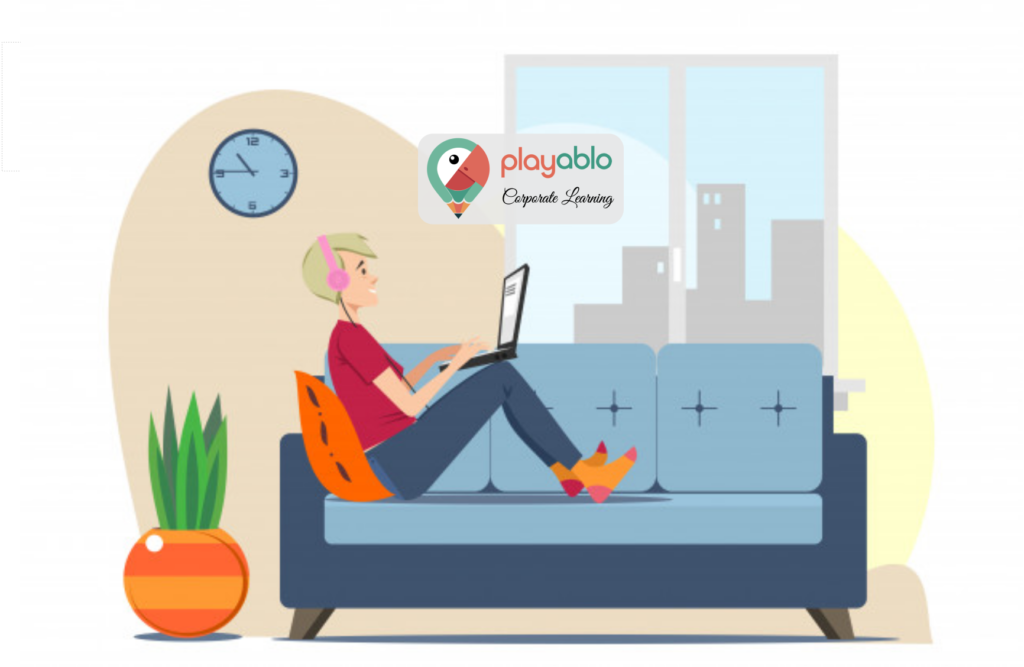The post pandemic workplace! Well, the ongoing COVID-19 pandemic has forced corporates to put an indefinite pause on their offline workplaces. Remote work and remote learning are now in the spotlight. Shortly, this trend will drastically change the way people work. Now, to stress the fact that quantifiable numbers support our claims, here are some vital stats:

- 77 percent of the workforce wants to continue working from home, at least once a week, in the post pandemic workplace situation.
- Over 23-30 percent of employees will end up working from home multiple days a week, even by the end of 2022.
- Given an option, 99 percent would choose to work remotely for the rest of their careers.
- For 83 percent of employees, the ability to work remotely, at least in some capacity, is a deciding factor while considering a job offer.
- 90 percent of employees believe that flexibility in their work arrangements helps improve their morale.
- Remote workers can be 20-25 percent more productive than their colleagues who work from offices.
- Employees who work remotely at least one day a month are 24 percent more likely to be productive and happy.
- 76 percent of employees prefer to avoid their office altogether when they need to concentrate on a project.”
[Source]
Table of Contents
So What Does This Mean for the Future of Remote Learning in the Post Pandemic Workplace?
As you can see, virtual working does not cause a deficiency in performance or negatively impact productivity in any way. Flexibility and the ability to work at one’s own will are factors that motivate employees to put forward their best foot.
Now, in the post pandemic workplace scene, with this change, traditional, in-person training no longer seems viable. Offline courses and remote learning offer limited scope, are restrictive, and not to mention, expensive. The model just does not fit the modern, flexible work culture — dominated by the digitally native Millennials and Generation Z.
Additionally, with offices scattered worldwide, remote learning gives corporates the option to train every staff member — irrespective of location. Also referred to as distance trainning, remote learning enables learners to access knowledge even if they are not in physical proximity. Furthermore, with the advent of technologies like Learning Management Systems, remote learning is effortless to implement.
That being said, your next question is: how to create an impactful remote learning program in the post pandemic workplace? Well, we are here to answer just that.
How to Launch an Effective Remote Learning Program in the Post Pandemic Workplace?

eLearning, AKA virtual learning, remote learning, or online training, offers multiple benefits. But even then, you must be careful while implementing this model — especially when dealing with a modern workforce with varied skillsets. Here are some factors you must keep in mind while deploying remote learning in the post pandemic workplace — so that you do away with some of the flaws of this system.
Go Blended
The only element missing in remote learning is physical interaction. In face-to-face training sessions, we have physical interactions between the instructor and learners. There are multiple activities, such as group projects and discussions. So, how do you address this aspect in online training modules?
Go for a blended experience, which brings in the best of both worlds. It combines traditional training methods with modern, online techniques. Again, you can go a step ahead and replace face-to-face, in-person learning sessions with webinars and ILT sessions.
Adopting the above measures in the post pandemic workplace means your business can reach all of your remote learners, while also delivering an interactive learning experience. Additionally, give your trainees the chance to ask questions and chat with each other. You may again ask your instructors to provide instant feedback and answer queries. As you can see, blended learning is the perfect combination of old and new training techniques.
Make Remote Learning Accessible
Another concern voiced by corporates before launching an eLearning platform is accessibility. For instance, if your employees are out of the office, trainers can feel that they do not have adequate control of their remote learning schedules. For example, one cannot track the device learning is accessing knowledge.
Usually, the modern learner prefers mobile learning to absorb information on the go, in manageable chunks, at their own pace and place. Therefore, when creating your remote learning strategy, keep this top of mind. Again, you must be aware of the two essential elements of mLearning — the type of LMS used by your company and the responsiveness of the solution.
Mobile-friendly remote learning needs you to be aware of two aspects. Firstly, check the learning management system your organization uses. It should be responsive. Usually, you should pick an LMS that works in a browser on a mobile or tablet device or has its iOS app.
Again, your remote learning content needs to be mobile-friendly as well. When you design your modules using an authoring tool, keep the courses short and digestible. In short, go for micro-learning since it makes training more accessible and learner-friendly.
Ad: PlayAblo’s Enterprise-Grade Micro-Learning platform is for the modern corporate learner. Micro-Learning, along with assessments and gamification features, ensures learning outcome measurement along with sustained engagement.
Find out more and request a custom demo!
Introduce Engagibility
You know that saying in relationships. Out of sight, out of mind. Well, the same adage holds for remote learning as well. When an instructor is not present physically to motivate the learners, it often forces employees to procrastinate or fix their training schedules—in such a case, having the perfect and comprehensive LMS can solve all issues related to remote learning engagement.
One of the tried and tested methods to enhance trainee motivation is notifications. For instance, when an employee signs up for an online training program, s/he can get a notification that reminds them to start training. You can then choose to send reminder emails that remind learners of upcoming deadlines, prompting them to finish their courses.
Using Gamified Tools
Inviting employees to enroll in a remote learning program is not a burdensome task if you know how to do it well. When you introduce gamification, remote learning can be an engaging and enjoyable experience for your remote workers.
You can use these tools to give points, level up, earn badges, or compete on a leaderboard to gauge whose learning prowess is the best. Of course, some of the work needs to be done by your organization’s instructors too. Be it via a Google Hangouts call or on the LMS itself, trainers require to offer feedback and nurture a remote learning culture through every step of the training.
Ad: PlayAblo’s Enterprise-Grade Micro-Learning platform is for the modern corporate learner. Micro-Learning, along with assessments and gamification features, ensures learning outcome measurement along with sustained engagement.
Find out more and request a custom demo!
Introduce the Social Factor
As already mentioned, eLearning can become a monotonous experience if employees feel that they are isolated. Therefore, it is always a great idea to create a more social learning environment. Then, employees can share their experiences and learn from one another.
You can use many tools to make remote training more social. Introduce chatrooms, embed modules with social media channels, and encourage learners to partake in online forums. And one of the best ideas is to introduce a discussion forum in your LMS. With discussion forums, you can make learning a talking point.
Your employees can interact with their instructors and other team members, ask questions about training, and share resources. All this makes learning a more social experience.
Well, That Sums it Up!
If you plan to make remote learning successful in the post pandemic workplace, then follow these simple steps are you are all set!
Ad: PlayAblo’s Enterprise-Grade Micro-Learning platform is for the modern corporate learner. Micro-Learning, along with assessments and gamification features, ensures learning outcome measurement along with sustained engagement.
Find out more and request a custom demo!







2 Comments
Comments are closed, but trackbacks and pingbacks are open.